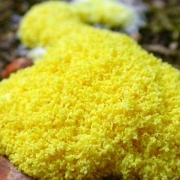Smart Slime Mold Confusing Scientists
Slime mold made its debut at the Paris Zoological Park in October 2019.
The Zoo’s newest resident is not a mold at all. In fact, neither is it a plant or animal. It is a unique Amoeba with 720 sexes. Even without a brain, it has the ability to split into different beings before glomming back together. It has no brain, but it can learn to do things, like navigate through a maze in search food. Some scientists think it could be ‘taught’ to project the most efficient travel routes between cities.
“The blob is a living being which belongs to one of nature’s mysteries,” explained Bruno David, the director of the Paris Museum of Natural History. Slime mold is not a plant, animal or fungi. “It surprises us because it has no brain, but is able to learn. If you merge two blobs, the one that has learned will transmit its knowledge to the other.”
According to the zoo, the blob’s favorite food is oatmeal. However, in nature it loves to gobble up fungi. If you were asked to describe it, you would probably say it looks like strings of colored yarn.
After being grown in Petri dishes, it was grafted onto tree bark and placed in a terrarium.
See slime mold grow on Youtube.com
NOTE: Slime Mold is an informal name given to several kinds of unrelated organisms that can live freely as single cells, but can aggregate together to form multicellular reproductive structures. It was formerly classified as fungi but are no longer considered part of that kingdom. The blob is not a plant or animal. It’s not a fungus, though it sometimes resembles one. In fact, this pseudo mold is a soil-dwelling amoeba, a brainless, single-celled organism, often containing multiple nuclei. This fact makes this unique species even more unique and interesting.
History
Researchers have started reconstructing the DNA of this soil amoeba. They found that the species is billions of years old. Slime molds have almost no fossil record. Not only do they produce few resistant structures (except for spores, which are often overlooked or unidentifiable), but they also live in moist forest habitats, such as on decaying wood or fresh cow dung. Therefore, their potential for preservation is low. A few fossils have been found in amber, a fossilized resin. Because of its original sticky nature, it sometimes preserves bugs, animals and plant matter as it hardens.







